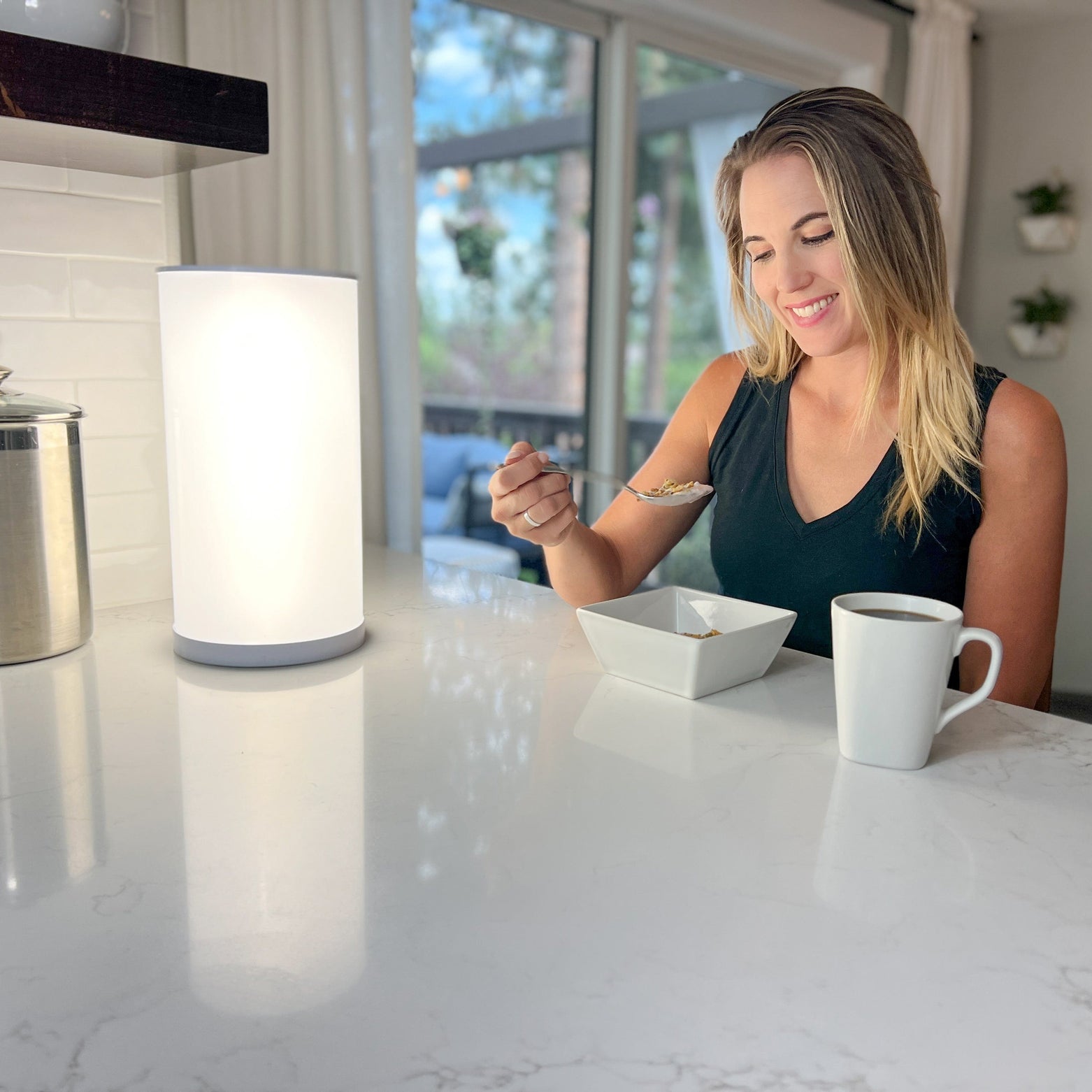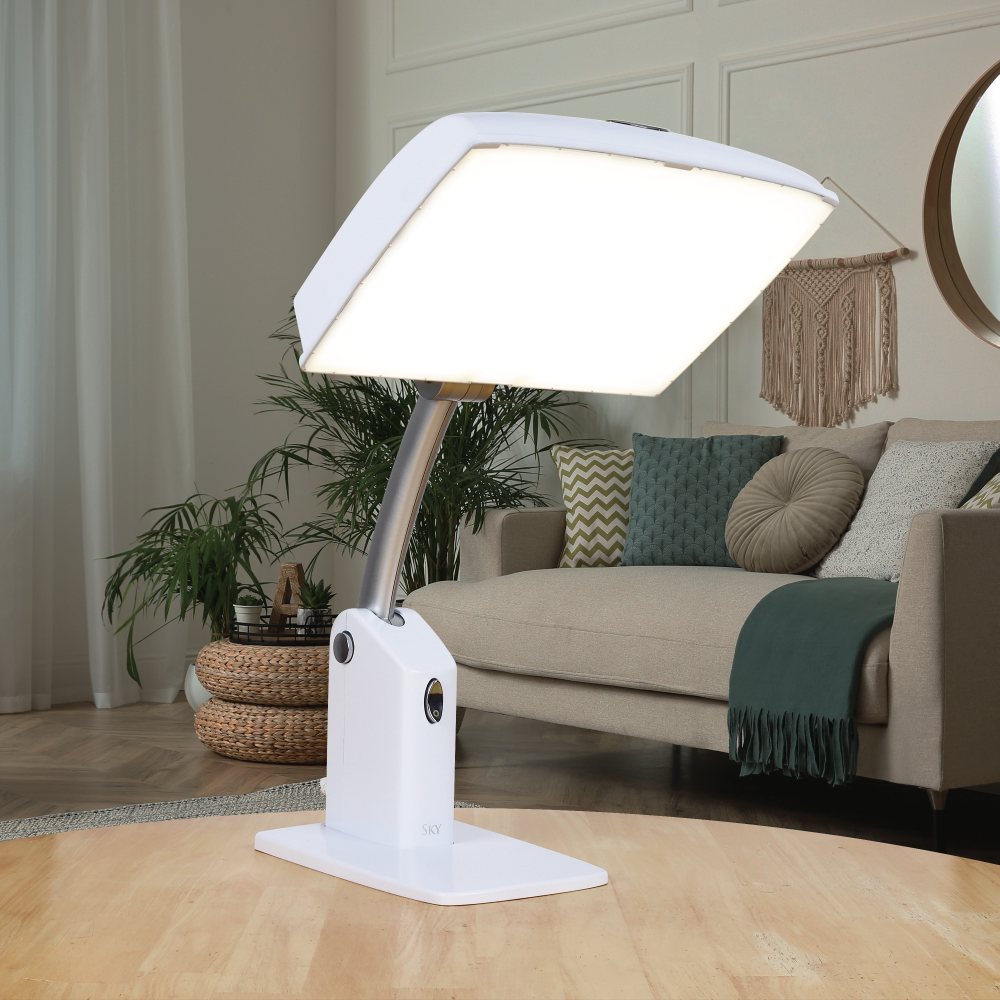Bright light therapy involves exposure to an artificial light source to mimic exposure to sunlight. The standard output of a light therapy device ranges from 2,500 to 10,000 LUX. The LUX is a measurement of the light's brightness.
Light exposure therapy may have the following benefits:
- Help align your circadian rhythm
- Improve consistent sleep patterns
- Increase alertness
- Balance the level of serotonin in the brain
- Positively affects energy level and mood
The article below will provide a guide as your one-stop resource for understanding bright light therapy including conditions it may help and factors to consider when selecting a light.
Understanding Light and Our Bodies

Your body has an internal clock, called your circadian rhythm, that tells you when to sleep and when to wake up. Sunlight has an influence on your circadian rhythm.
Your circadian rhythms controls many things, such as:
- Alertness
- Daily cycle of hormones and
- Body temperature
- Sleep cycle

Disruptions in your exposure to light and dark can affect your circadian rhythms. Disruptions can occur due to factors such as:
- Seasonal changes
- Shift work
- Traveling across time zones
When your circadian rhythm becomes disrupted, it can lead to various negative consequences, such as sleep problems, depression, memory issues, and mood disturbances.
According to a report by the Environmental Protection Agency, most Americans spend about 90% of their time indoors. This extensive amount of time indoors can lead to light deprivation, which may have adverse effects.
What is a Light Therapy Lamp?
A light therapy lamp is a special kind of lamp that emits a wavelength of light at therapeutic levels to mimic natural sunlight. Light therapy lamps are used to treat various sleep and mood disorders. Key features of the lights include:
- Color temperature
- Brightness
- Light spectrum
- Viewing angle
- Light sources ( LED or fluorescent)
There are different types of light therapy lamps available, such as the following:
- Light box
- Desk lamp
- Light visor
- Dawn simulator

How Does Light Therapy Work?
Light exposure plays a role in producing brain chemicals such as melatonin and serotonin. Melatonin is a hormone that helps promote sleep, and serotonin affects mood, appetite, energy levels, and memory.
Exposure to a light therapy lamp mimics exposure to sunlight. Similar to sunlight, the light from the lamp promotes the production of melatonin and serotonin. This may help treat conditions that occur as a result of a decrease in these chemicals.
Bright light therapy should not be confused with UV therapy. UV light has a different wavelength from bright light therapy. The intended treatment also differs. UV light is primarily used to treat skin conditions. However, UV light may have significant side effects. For example, UV light may increase the risk of skin cancer damage to the eyes and cause sunburn. Bright light therapy does not cause these side effects.

Benefits and Uses of Bright Light Therapy
There are several potential benefits to bright light therapy for various conditions, including the following:
Seasonal Affective Disorder (SAD)
Seasonal affective disorder (SAD) is a form of mood disorder that usually occurs during certain seasons, primarily winter and fall. Researchers theorize it may occur due to a combination of factors, such as genetics, changes in brain chemicals and a decrease in sunlight.
Studies show bright light therapy to be an effective nonpharmaceutical treatment. For example, this 2020 meta-analysis reviewed 19 studies involving bright light therapy as a treatment for SAD. Researchers found that bright light was superior over a placebo in decreasing symptoms of SAD.

Non-Seasonal Depression
Light exposure therapy may also help treat non-seasonal depression. A meta-analysis published in the Journal of Affective Disorders analyzed nine trials on light therapy as treatment for depression. Research indicated that bright light therapy appears to be an effective treatment for depression especially when administered for 2 to 5 weeks duration.

Sleep Problems
Sleep problems may include a variety of issues, such as falling and staying asleep.
A meta-analysis and systematic review published in the journal Sleep Medicine Reviews involved 53 studies with 1,154 participants. Researchers found that bright light therapy was effective in treating:
- Insomnia
- General sleep problems
- Alzheimer's-related sleep problems
- Circadian rhythm sleep disorder
Mood Disorders
Serotonin levels may also affect the development of mood disorders. A narrative review using Google Scholar and Medline published in the Frontiers in Psychiatry reviewed the efficiency of bright light therapy in treating mood disorders. The literature review found that bright light therapy was an effective treatment including as an adjunct therapy for bipolar subtypes of mood disorders.

Jet Lag
Jet lag is a temporary sleep disorder that may occur when traveling across time zones. You may become out of sync with your internal circadian clock when traveling across time zones.
According to the American Academy of Sleep Medicine, exposure to sunlight or bright light therapy may help prevent jet lag. A study on jet lag found that light therapy is effective in creating a delay or advance in circadian rhythms, which is known as a phase shift. Participants exposed to 3 days of light therapy experienced an average circadian rhythm shift about 2.1 hours. Exposure to the light helped reset the circadian rhythm and adjust to the new time zone, preventing jet lag symptoms.
Low Energy Levels
Fatigue and low energy can occur for a variety of reasons including depression, lack of sleep, and certain medical conditions.
For example, this study found that exposure to bright light therapy reduced fatigue in people with multiple sclerosis after 14 days of use.
The study involved 26 patients with multiple sclerosis. Half of the patients received bright light therapy with a brightness of 10,000 LUX, and the other half received red light therapy with an intensity of less than 300 LUX. The group that received red light showed no decrease in fatigue, but the group that received bright light therapy reported a decrease in fatigue after 14 days.

Senile Dementia
Sleep disturbances are a common symptom of dementia. Some studies indicate bright light therapy may be effective in treating sleep disturbances related to Alzheimer's or other forms of dementia. Studies on bright light therapy and Alzheimer's patients found that bright light is effective in treating sleep disturbances in patients
- Who have a shorter duration of the disease
- Are in a mild to moderate stage of their condition

Shift Work Adjustment
People who work night shifts or early morning may develop sleep disorders because they go against their natural internal clock.
Studies show that light exposure therapy may help decrease sleep issues in people who do shift work outside the typical 9-to-5 schedule. For example, research published in the Journal of Clinical Sleep Medicine indicated that using light therapy can help reset circadian rhythm.
How to Use Light Therapy
Specific recommendations for using a light therapy lamp may depend on the condition being treated. However, according to the Mayo Clinic, general recommendations include the following:
- Use for about 20 to 30 minutes daily.
- Place about 16 to 24 in from your face but always follow the manufacturer's instructions about distance.
- Try to begin your session shortly after waking up and at the same time each day.
- To mimic the sun, the lamp should project light from above.
- Keep your eyes open but do not look directly into the light.
- Avoid turning away from the light.
- Most people will not need to use eye protection. However, if you have any type of eye disease speak to your eye specialist to determine if you need to use eye protection.
Is Light Therapy Safe?
Light therapy is generally safe for most people. Potential light therapy side effects are mild but may include headaches and eye strain. However, it is important to consult a doctor before starting bright light therapy especially if you take certain medications that may make you sensitive to light or have certain health conditions.
How to Choose a Light Therapy Lamp: Key Considerations
There are several factors to consider When selecting a light therapy lamp such as the following:
- LUX: Look for a lamp with an output of 10,000 LUX.
- Glare (Lux/in2): Select a light therapy lamp that is glare-free which is easier for the eyes.
- Surface area: A surface area that is at least about one foot square is optimal.
- Angle: Choosing a light therapy lamp that allows you to tilt is helpful to get the exact angle you want.
- Color temperature: The color temperature is the coolness or warmth of the light. It is measured in kelvin (K). Cooler lights at about 10,000 K promote alertness. Warmer lights at around 1000 K promote calmness.
- Size and portability: Consider the space you will use the lamp in and also if you plan to move it from room to room.
- UV filtration: Opt for a light that has UV filtration to decrease exposure to UV radiation.
- Special features: Some lights may have additional features, such as timers.
Wellness vs Therapeutic Grade Lamps
There is a difference between medical grade light therapy lamps and health and wellness grade lights.
Medical grade bright light lamps are typically larger and direct the light downward from an upward position. They also produce 10,000 LUX from 12 inches away .
Health and wellness grade lights are made to treat milder conditions. They tend to be smaller than medical grade lights. Although they may also produce 10,000 LUX, it is usually from 10 inches away. This may require sitting in front of the light longer than 30 minutes daily.
Frequently Asked Questions
What is the difference between a light therapy lamp and a regular lamp?
There are several differences between a light therapy lamp and a regular lamp, including:
- Light intensity: Light therapy lamps emit a higher intensity than regular lamps due, which has a therapeutic effect.
- Light spectrum: Light therapy lamps emit a full spectrum of wavelengths, including light and/or blue light. Regular lamps produce a specific wavelength and spectrum.
- Color temperature: Light therapy lamps produce a cool temperature, which mimics daylight. Regular lamps produce a warmer temperature color.
Can a light therapy lamp damage my eyes?
Light therapy lamps are generally safe for your eyes. Usually, light therapy lamps have a feature that filters out UV rays, which decreases the of eye damage.
What is the difference between light therapy and UV therapy?
UV therapy uses ultraviolet rays, which is the same type of light emitted from the sun. It may be used to treat certain skin conditions. Light therapy uses a different wavelength from UV and is used to treat sleep related conditions and mood disorders.
Conclusion
Exposure to bright light therapy can mimic exposure to sunlight promoting melatonin and serotonin production. Bright light can improve conditions such as seasonal depression, mood disorders, and sleep related issues. Light therapy may have a positive effect on quality of life and improve overall well-being.
You can find quality bright light therapy lamps here or on Amazon. It may also be helpful to ask your healthcare provider for recommendations on where to purchase a quality light therapy lamp.
Additionally, it is always advisable to consult your doctor for personalized guidance in using bright light therapy.







Leave a comment
All comments are moderated before being published.
This site is protected by hCaptcha and the hCaptcha Privacy Policy and Terms of Service apply.